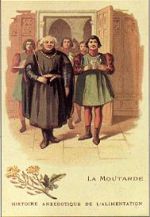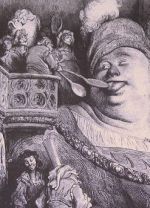 |
All about mustard > A Short History of Mustard
If mustard is not quite as ancient as the world itself, it was nevertheless part of the oldest Mediterranean cultures. Prized by the Egyptians, Greeks and Romans for the way it enhanced fish and meats, it was found on every Roman table in the first century AD. The greatest philosophers of the era attributed it with an ability to enflame the senses… thus making it very popular!
This belief survived for centuries, and was still current much later in Denmark. Apothecaries made a fortune by preparing a concoction made of mustard seeds, ginger and mint which love-starved husbands gave to their wives in the hope of making them more receptive to their amorous advances.
Though mustard never really gained huge popularity in northern Europe, sprinkling a handful of mustard seeds around was still seen as an effective way to protect the house from evil spirits - a belief that extended all the way to India.
But let's return to the time of the Romans. In ancient Rome, Apicius was already creating mustard-based sauces to serve with fried doves, boiled birds like duck, crane and ostrich, and of course boiled sausages. When the Romans invaded Gaul, they brought with them a taste for mustard; later on, the emperor Charlemagne recommended growing this spice in all his estates general, particularly in the gardens adjoining the monasteries on the outskirts of Paris.
Mustard-growing gradually gained favour in Germany as well. There was a whispered legend in that country that if a woman sewed mustard seed into her wedding dress, she would be assured of wearing the pants in the family throughout her marriage! Mustard arrived in England in the 12th century.
Is like a sausage without mustard
In Spain, the consumption of mustard also began with the arrival of the Roman legions; Vasco de Gama sailed off into unknown waters to discover the passage to India with a barrel of mustard on board. Mustard is found everywhere: it is grown as part of crop rotations for forage, and is used as a vegetable and for its oil.
The lighter side of mustard
If mustard has become almost as much a part of our daily meals as sugar and salt, it has still not become commonplace in the customs of some regions and countries. One day, in the far reaches of Estonia, two peasants sat down at a table in a hotel restaurant in the capital to celebrate the profit they had pocketed that day at the horse market. As they were reliving some of their more lucrative trades, they saw some gentlemen at a neighbouring table spooning a yellow cream from a small crock, parsimoniously dabbing a little on each bite of beef that they brought to their mouths. "That must be very expensive for them to be using it so sparingly," said one of the two peasants. "Let's show them that country folk know how to live handsomely," replied the second. "We'll order a whole bowlful!" "Why not a bowl each?" countered the first. "Let's eat like worldly men!" Unsuspecting, but proud as peacocks, they dug right into their bowls of mustard with a spoon. Soon their eyes were watering and their throats burning. Even the mugs of beer could not ease the heat. "Never again!" exclaimed the peasants. "The food of fashionable men isn't made for decent folk."
Having your head plunged into a barrel of mustard can make you hot-headed!
In Scandinavian countries, the Danish followed the culinary habits of the nobles and continued to use mustard after the Swedish conquest. As for Norway, it had its first encounter with this condiment in an atmosphere of violence. In 1234, the Orkney Islands had fallen into anarchy and the Vikings, biding their time on the Isle of Man, quickly set sail for this tumultuous archipelago. As soon as they disembarked, however, they were captured by the Earl of Conway. The lord used some strange strategies that have gone down into the annals of maritime history, since instead of taking the invaders prisoner, he rolled out casks of mustard onto the beach, one for each Viking, and stuck them all head first into a barrel. Maybe this is the origin of the French saying "La moutarde me monte au nez" - literally "The mustard is getting up my nose," meaning "My temper is flaring up." Whatever the origin, having your head stuck into a barrel of mustard will undoubtedly make you hot-headed!
Earlier, in 1382 Duke Philip the Bold had inscribed on the city of Dijon's coat of arms "Moult Me Tarde," meaning "I ardently desire." The motto soon appeared on all pots of mustards. Mustard-making was becoming increasingly refined, and in 1390 its production was regulated: anyone caught making an inferior product and passing it off as mustard was subject to harsh penalties. Two centuries later, the corporation of vinegar and mustard makers of Dijon was formed, under the patronage of St. Vincent, with the degrees of master, companion and apprentice. Jurors appointed at the beginning of each year were responsible for seeing that the statutes and ordinances laid down in 1634 were respected in order to protect the profession against frauds and poor-quality products. The creativity of the vinegar and mustard makers led to the wide variety that we know today. The title "moutarde de Dijon" is reserved for prepared mustards made with "bolted" mustard (meaning that the tegument or seed coat has been removed by sieving), or sifted mustard whose content of total dry extractives (salt and sugar included) must not be less than 28%; the level of tegument not removed by the bolting process must not exceed 2%.

wrote Jehan Millot, canon of Lille in the 14th century.
In medieval France, it was not uncommon to see children armed with pots heading for the busy market street to fetch wine or mustard while their mother stayed home to watch over the other children and the pot simmering over the fire. Inseparably associated with the city of Dijon, mustard held pride of place on the table of the Dukes of Burgundy, those bon vivants who loved it for its taste, as well as its digestive and antiseptic properties. They would even regularly send barrels of it to the court of the French king. Louis XIV never went anywhere without his mustard pot, according to contemporary accounts, and we might add, without tarnishing his image too much, that the Sun King favoured a mustard colour for his clothing.

a honorary title that came from a Pope's love of mustard
In the 14th century in Avignon, the city of the popes, John XXII became so fond of this condiment that he created the post of "Pope's First Mustard-Maker." In the 16th century, Pope Clement VI, a native of the Limousin region, nicknamed "The Magnificent" because of the pomp of his pontifical court in Avignon, suddenly remembered while at table one day that the region of Roziers-d'Egletons in Corrèze, his birthplace, made a unique purple mustard. He sent an urgent order, summoning a mustard-maker to Avignon to prepare the famous mustard for him. Messire Jaubertie performed his duty so well that he was named "Grand Moutardier du Pape."

And then there is Rabelais' Gargantua, the legendary giant of the 16th century, who required four servants to provide him with mustard…. He started off his meal with a few dozen hams and smoked beef tongues, sausages and other such things, while four of his men threw shovelful after shovelful of mustard into his mouth.

-

 Recipes
Recipes
-

 Products
Products
-

 Entertaining
Entertaining
-

 Chefs
Chefs
-

 Hints & Tips
Hints & Tips
-

 Glossaries
Glossaries








